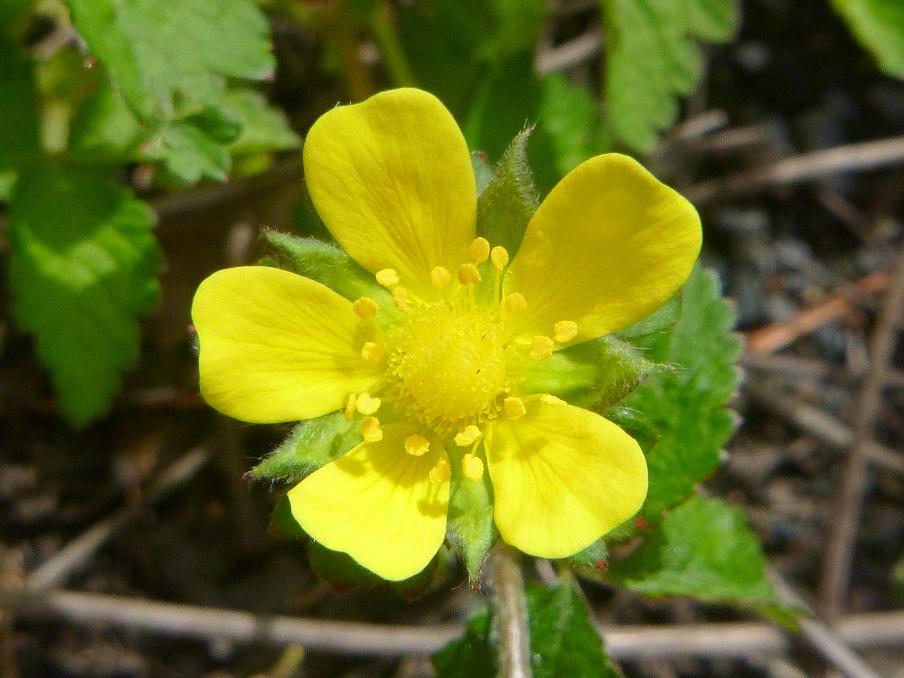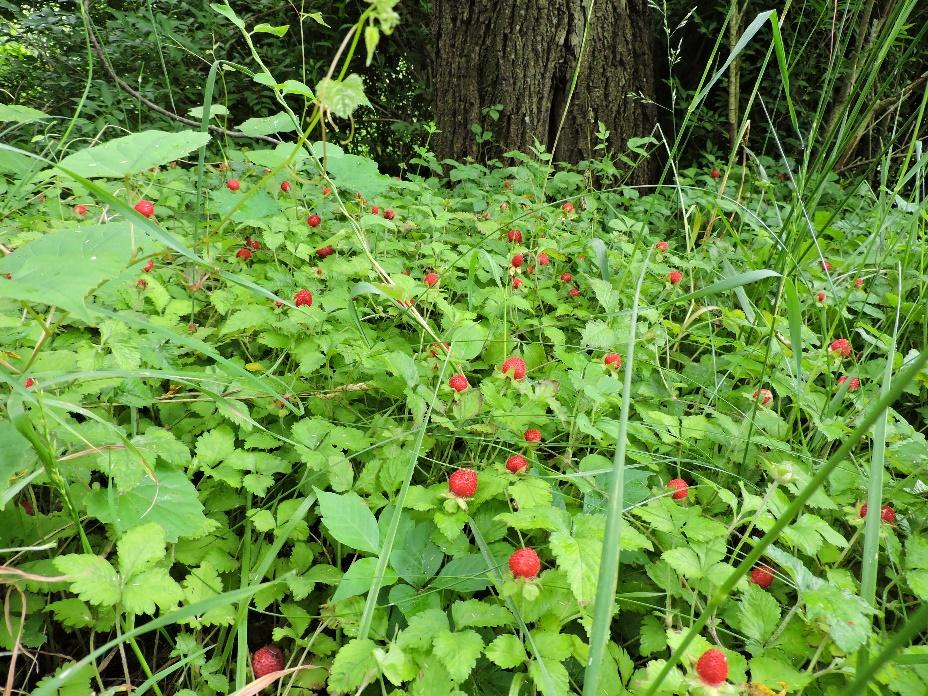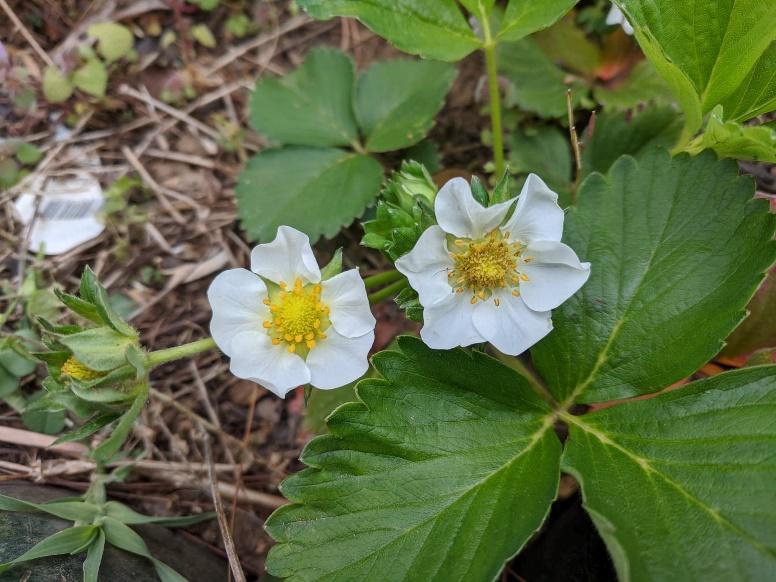Name: Strawberry, Wild
Botanical Name: Fragaria virginiana Duchesne
Form: Vine
Parts Used: Berries, greens
Citation: Guenther, K. (2021, January 1) Wild strawberry as wildlife food [Web log post.] Retrieved: supply the date, from http://wildfoods4wildlife.com

Getting Started
In this document, we’ll look at a few different “strawberries” including two fakers!
Strawberries—being vines—are frequently described as ‘invasive’ which sounds bad. But it is the nature of strawberries to form spreading carpets! There are four different “things-called-strawberries” in my area. Three are natives but only the two Fragaria species are true strawberries.
Rosaceae (Rose Family)
Fragaria (Strawberry Genus)

| Common name | Virginia Fragaria species | Origin | Rare Plant Status |
| woodland strawberry | F. vesca | native | The variety ‘americana’ is globally secure, but critically endangered in Virginia. |
| wild strawberry | F. virginiana Duchesne | native | Not rare. |
| strawberry | F. [chiloensis X virginiana] | native | Not rare. |

Virginia Botanical Associates. (Accessed January 22, 2021). Digital Atlas of the Virginia Flora (http://www.vaplantatlas.org). c/o Virginia Botanical Associates, Blacksburg.
USDA, NRCS. 2015. The PLANTS Database (http://plants.usda.gov, 16 January 2021). National Plant Data Team, Greensboro, NC 27401-4901 USA.
Key Features to Look For
In addition to the identification guide of your choice, here are a couple of features you should see on wild strawberry:
- Low-growing plants that carpet the ground with runner vines that grow and put down roots at nodes along the vine
- The vine stems are stiff, reddish and hairy
- Flowers have five white round petals with yellow centers
- Leaves are in threes, hairy and coarsely-toothed
- Red berries are round with seeds embedded in the surface and look very similar to grocery store strawberries
Risks: None noted.
Flower Description: The flowers have five white regular, roundish petals around the yellow center. The stamens emerging from the center are large and yellow. The flower has its own stalk with no leaves and do not grow higher than the plane of the leaves.

Leaf Description: A leaf consists of three leaflets. Each leaflet is coarsely toothed. The stems of the leaves are hairy, as are the surface and undersides of the leaves, to some extent.


Fruit Size: Strawberries are round and look just like grocery store strawberries, though slightly smaller. Seeds are embedded in the surface of the berry. Strawberries are ripe when they are red.
Harvest
| Jan | Feb | Mar | Apr | May | Jun | Jul | Aug | Sep | Oct | Nov | Dec | ||||||||||||||
|---|---|---|---|---|---|---|---|---|---|---|---|---|---|---|---|---|---|---|---|---|---|---|---|---|---|
| winter | winter | late winter | early spring | spring | late spring | early summer | summer | late summer | early fall | fall | late fall | ||||||||||||||
| greens | x | x | x | x | x | x | x | x | x | x | x | x | |||||||||||||
| fruit | x | x | x | x | |||||||||||||||||||||
Is this a good enrichment item? Not particularly, though the vines’ stems lean towards being a little stiffer, so they do not wilt as quickly as a softer forb might.
How to Store Strawberries: When berries are red they are ripe to pick. This is a fragile fruit that is best used right away. Commercial berry containers are great for storing fruit because the rigid plastic keeps the fruit from getting crushed and they also have small holes in them that control the humidity in the container. This slows the fruit from drying out too quickly but allows air circulation to reduce molding.
Keep strawberries in re-used commercial berry containers in the refrigerator for at least one to two weeks and potentially longer.
DO NOT WASH THE FRUIT until you are ready to use it. And strawberries-being such a juicy, fragile fruit, turn to mush if frozen.
Harvesting Strawberry Greens
If you choose to, use a commercial vegetable cleaner or a ¼ cup of vinegar added to wash water as a cleaner. Submerge the plant material and swish it around to remove all dirt from leaves. Rinse in clean water. Always wash greens; you never know what might be on them…like animal feces or urine. Place in a colander or salad spinner to drain, then lay out a towel and spread the greens on the towel and roll up the towel. Unroll and transfer the damp greens to storage.
For storage, there are a couple of different possible container methods. If the greens will be used quickly within days, place the towel-rolled damp greens in a 1-gallon zip-lock baggie with 12-15 holes cut in it to provide air and keep the greens from molding (or reuse commercial grape bags with holes). Label the bag with the plant name and which animals it should be used for. Keep container in the vegetable drawer of the refrigerator.
Many greens are very sensitive to exposure to ethylene gas, though greens themselves are low emitters of the gas. You may get longer quality by adding a product that reduces free ethylene gas in the refrigerator. Greens are good until they become dry and crispy, fade in color, or become slimy or moldy.
Comparing Different “Things-Called-Strawberries”
wild strawberry (Fragaria virginiana Duchesne)
- a true strawberry
- this is the one that animals love to eat and is basis of the domestic strawberry hybrids we humans love, too
- white, 5-petalled flowers
- vine has runners
Woodland strawberry (Fragaria vesca)
- also a true strawberry
- somewhat smaller than the Virginia strawberry, otherwise much the same. Also eaten by many animals
- white, 5-petalled flowers are usually on stems that stick up higher than the leaves
- vine has runners

Mock strawberry (Duchesnea indica also known as Potentilla indica)
- not a real strawberry, edible but tasteless
- one single yellow flower per stem
- pointed green sepals stick out from between the yellow flower petals
- vine has runners
- berry is juicy
- non-native
- this fruit is reportedly eaten by eastern box turtles. For some reason, I had it in my head that cottontails eat mock strawberry greens so I collected it and offered it to the rehab rabbits I forage for. They ate it in captivity, but they may or may not eat it in the wild.
Barren strawberry (Waldsteinia fragarioides also known as Geum fragarioides)
- not a real strawberry, edible but tasteless
- small clusters of yellow flowers
- not a vine, no runners
- berry is drier
- all leaves come from the base of the plant (basal) on long stems (petioles)
- flowers and fruits stick up higher than the leaves
- more rounded leaves than mock strawberry
- native
- I don’t know of any animals are known to eat these





Rare Strawberry Species in Virginia
| County in Virginia | Species | Alert |
| Bland | woodland strawberry | Globally secure but critically endangered in Virginia. |
| Highland | woodland strawberry | Globally secure but critically endangered in Virginia. |
| Roanoke | woodland strawberry | Globally secure but critically endangered in Virginia. |
| Smyth | woodland strawberry | Globally secure but critically endangered in Virginia. |
| Washington | woodland strawberry | Globally secure but critically endangered in Virginia. |
| Westmoreland | woodland strawberry | Globally secure but critically endangered in Virginia. |
Feed Wild Strawberry to:
strawberry | (Fragaria spp.) | fruit |
|---|---|---|
Bear, American Black | Ursus americanus |
|
Chipmunk, Eastern | Tamias striatus |
|
Cottontail, Eastern | Sylvilagus floridanus |
|
Elk, Rocky Mountain | Cervus elaphus |
|
Hare, Snowshoe | Lepus americanus |
|
Mouse, Common White-footed | Peromyscus leucopus |
|
Opossum, Virginia | Didelphis virginiana |
|
Skunk, Striped | Mephitis mephitis |
|
Squirrel, American Red | Tamiasciurus hudsonicus |
|
Squirrel, Eastern Fox | Sciurus niger |
|
Vole, Meadow | Microtus pennsylvanicus |
|
Blackbird, Red-winged | Agelaius phoeniceus |
|
Catbird, Gray | Demetella carolinensis |
|
Chat, Yellow-bellied | Icteria virens |
|
Crow, American | Corvus brachyrhynchos |
|
Finch, Purple | Carpodacus purpureus |
|
Flicker, Northern | Colaptes auratus |
|
Grackle, Common | Quiscalus quiscula |
|
Jay, Blue | Cyanocitta cristata |
|
Meadowlark, Eastern | Sturnella magna |
|
Oriole, Orchard | Icterus spurius |
|
Robin, American | Turdus migratorius |
|
Sparrow, House | Passer domesticus |
|
Sparrow, Savannah | Passerculus sandwichensis |
|
Sparrow, Swamp | Melospiza georgiana |
|
Sparrow, White-throated | Zonotrichia albicollis |
|
Thrasher, Brown | Toxostoma rufum |
|
Thrush, Wood | Hylocichla mustelina |
|
Titmouse, Tufted | Baeolophus bicolor |
|
Towhee, Eastern | Pipilo erythrophthalmus |
|
Veery | Catharus fuscescens |
|
Bobwhite, Northern | Colinus virginianus |
|
Grouse, Ruffed | Bonasa umbellus |
|
Pheasant, Ring-necked | Phasianus colchicus |
|
Turtle, Eastern Box | Terrapene carolina |
|
strawberry | (Fragaria spp.) | greens |
Chipmunk, Eastern | Tamias striatus |
|
Cottontail, Eastern | Sylvilagus floridanus |
|
Deer, White-tailed | Odocoileus virginianus |
|
Hare, Snowshoe | Lepus americanus |
|
Mouse, Common White-footed | Peromyscus leucopus |
|
Opossum, Virginia | Didelphis virginiana |
|
Skunk, Striped | Mephitis mephitis |
|
Squirrel, American Red | Tamiasciurus hudsonicus |
|
Squirrel, Eastern Fox | Sciurus niger |
|
Vole, Meadow | Microtus pennsylvanicus |
|
Grouse, Ruffed | Bonasa umbellus |
|
Pheasant, Ring-necked | Phasianus colchicus |
|
strawberry, Virginia | (Fragaria virginiana) | fruit |
Turtle, Eastern Box | Terrapene carolina |
|
strawberry, woodland | (Fragaria vesca) | fruit |
Bear, American Black | Ursus americanus |
|
Elk, Rocky Mountain | Cervus elaphus |
|
Raccoon, Northern | Procyon lotor |
|
Grouse, Ruffed | Bonasa umbellus |
|
Book & Journal References:
Fontentot, W.R. (2017). Avian Frugivory in Louisiana. Journal of Louisiana Ornithology. Vol. 10, pp. 11-40.
Martin, A.C., Zim, H.S., Nelson, A.L. (1951). American Wildlife and Plants: A Guide to Wildlife Food Habits. New York: Dover Publications.
Scott, M. (2013). Songbird Diet Index. National Wildlife Rehabilitators Association, St. Cloud, MN.
Townsend, J. F. (2019, March). Natural Heritage Resources of Virginia: Rare Plants. Natural Heritage Technical Report 19-15. Virginia Department of Conservation and Recreation, Division of Natural Heritage, Richmond, Virginia. Unpublished report.
Online References:
USDA, NRCS. 2015. The PLANTS Database (http://plants.usda.gov, 16, January, 2021). National Plant Data Team, Greensboro, NC 27401-4901 USA.
Virginia Botanical Associates. (Accessed January 22, 2021). Digital Atlas of the Virginia Flora (http://www.vaplantatlas.org). c/o Virginia Botanical Associates, Blacksburg.
